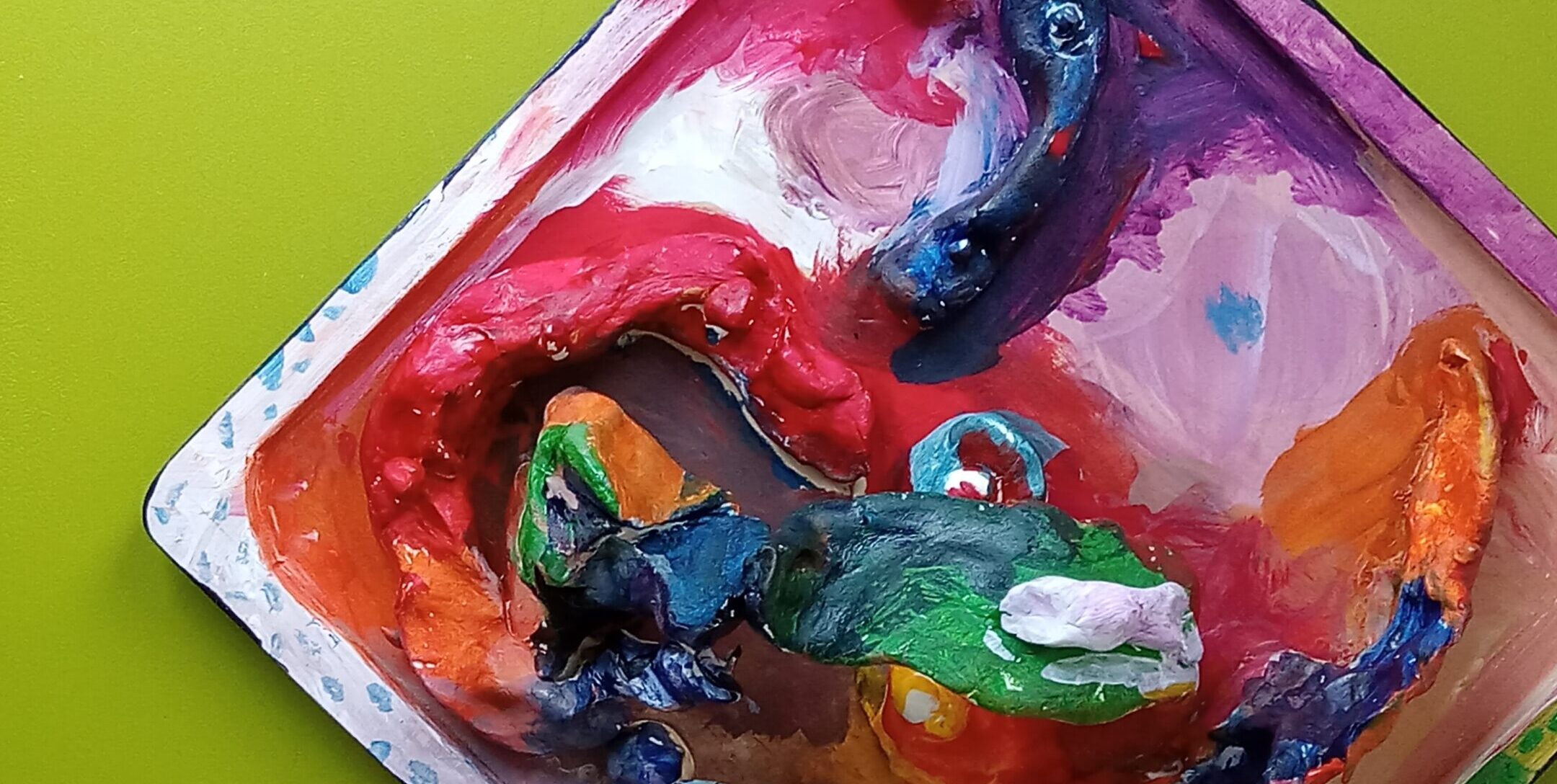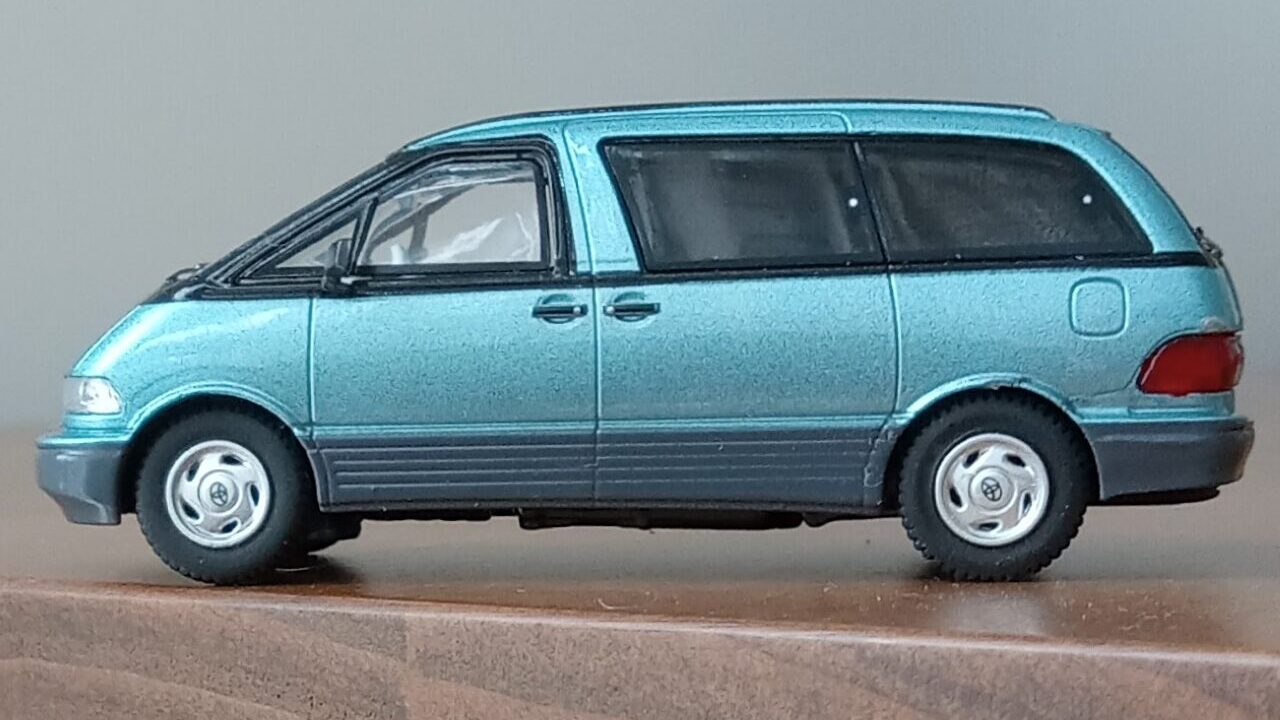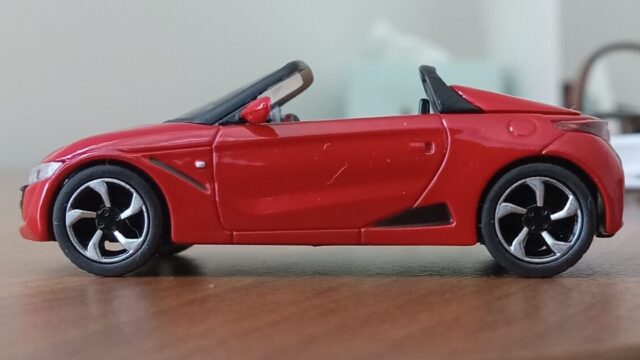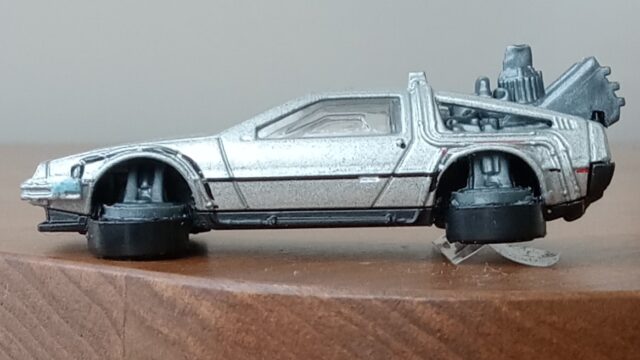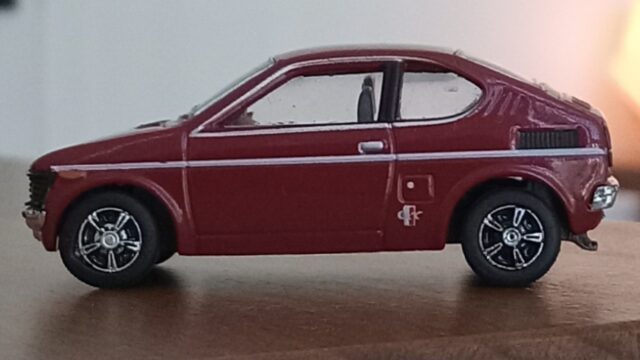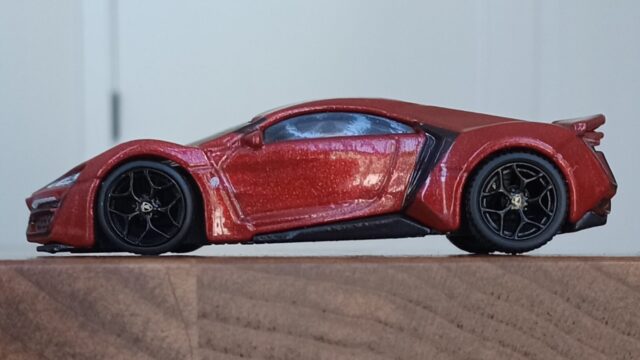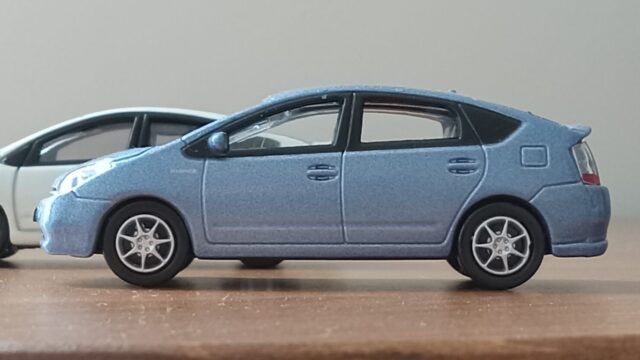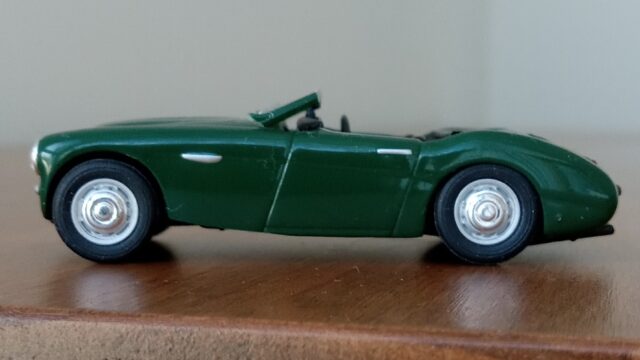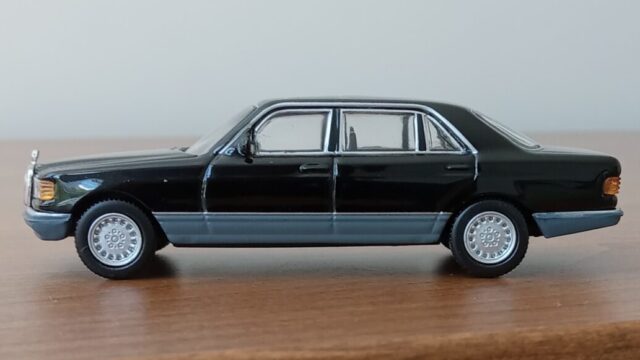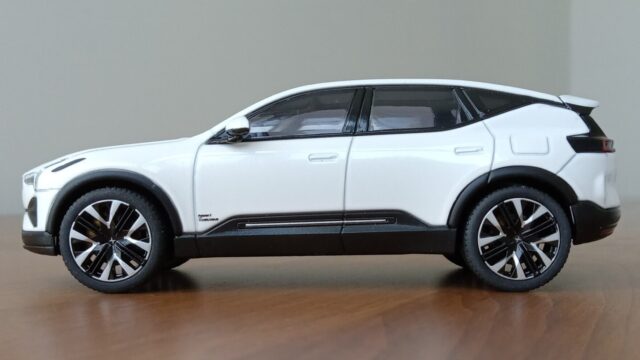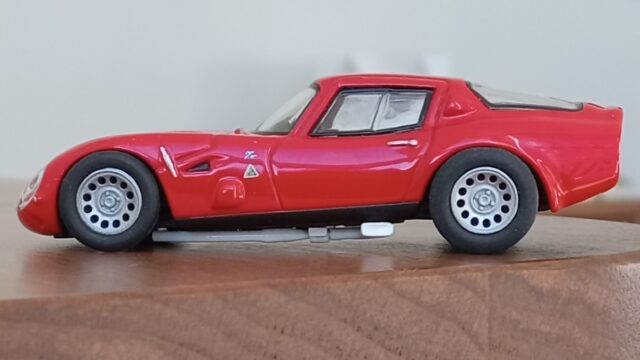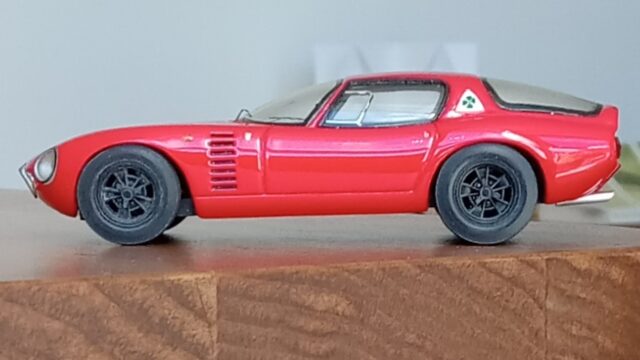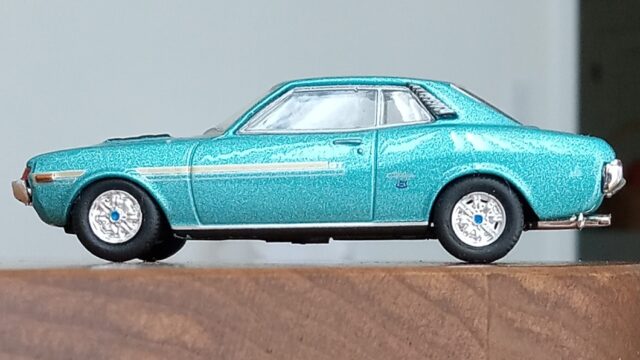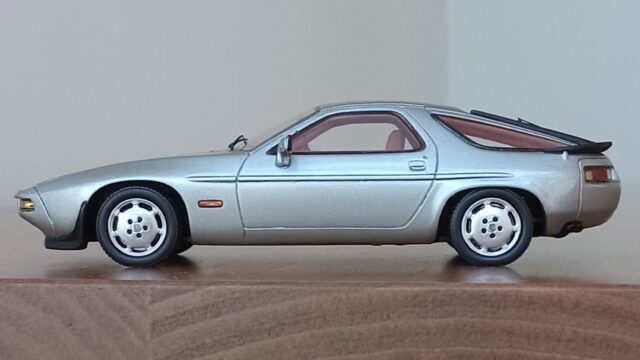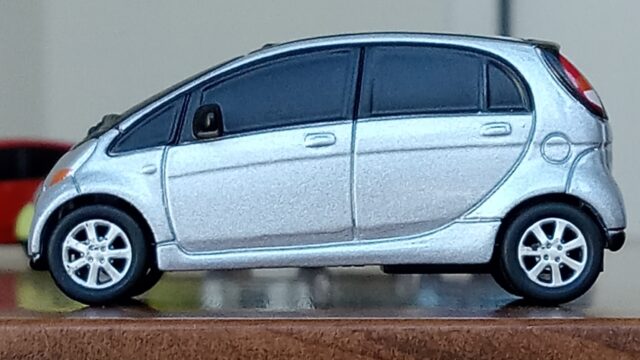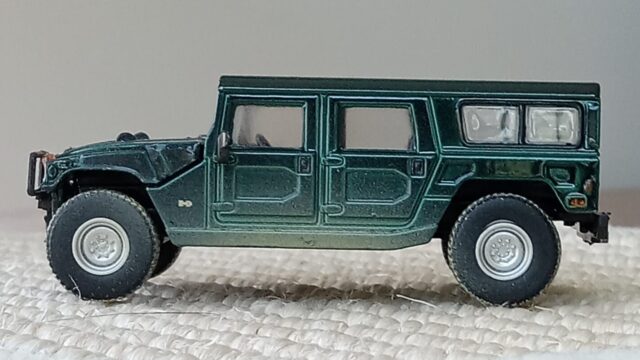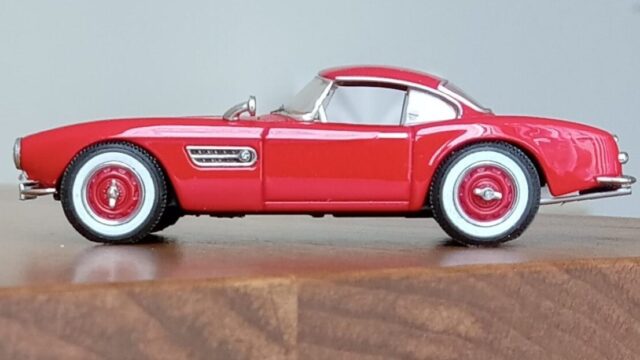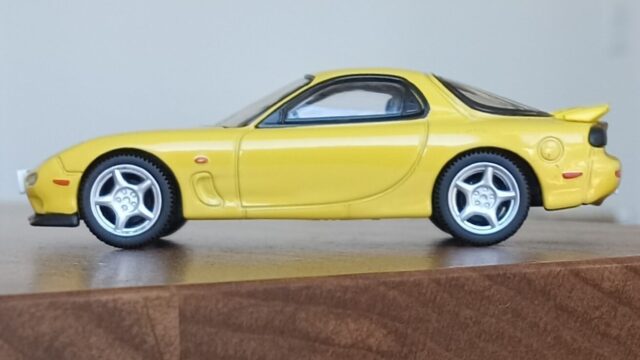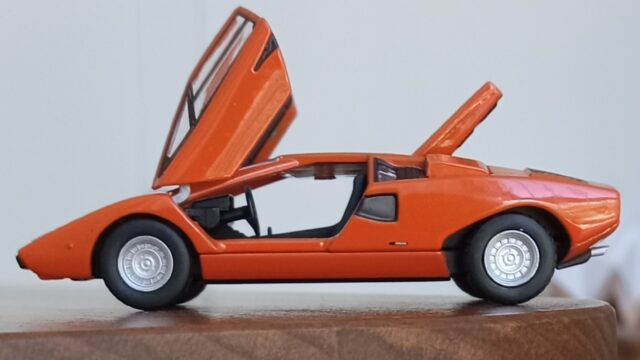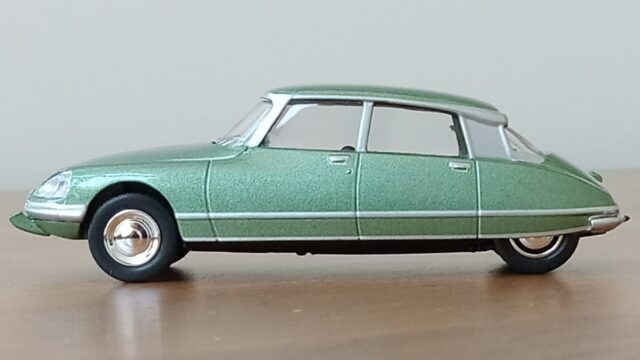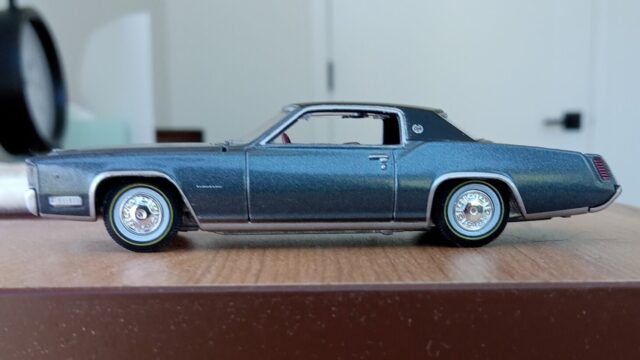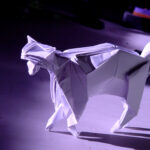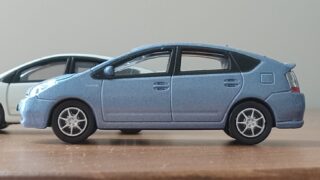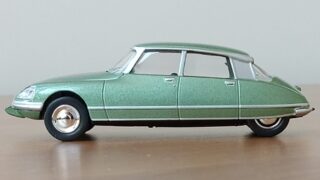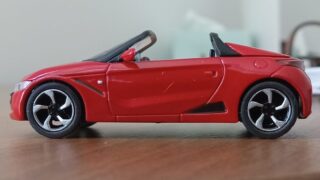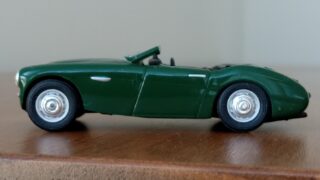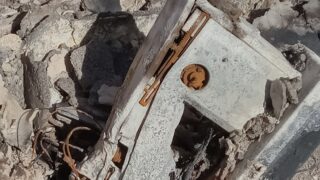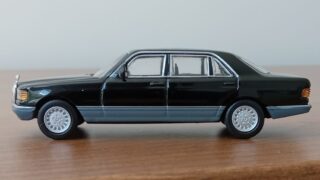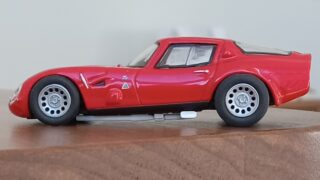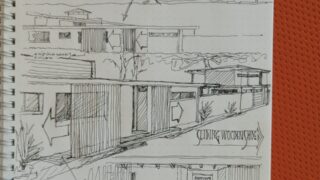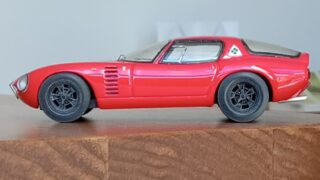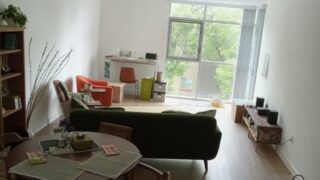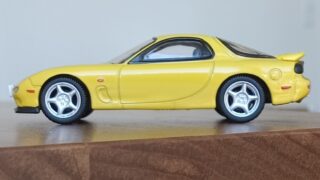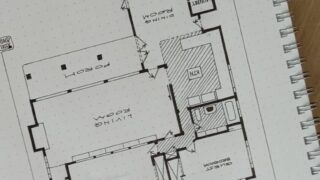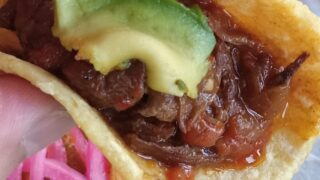第6回:トヨタ、初代プレビア【エスティマ】(外装色:グリーンマイカ/グレー)
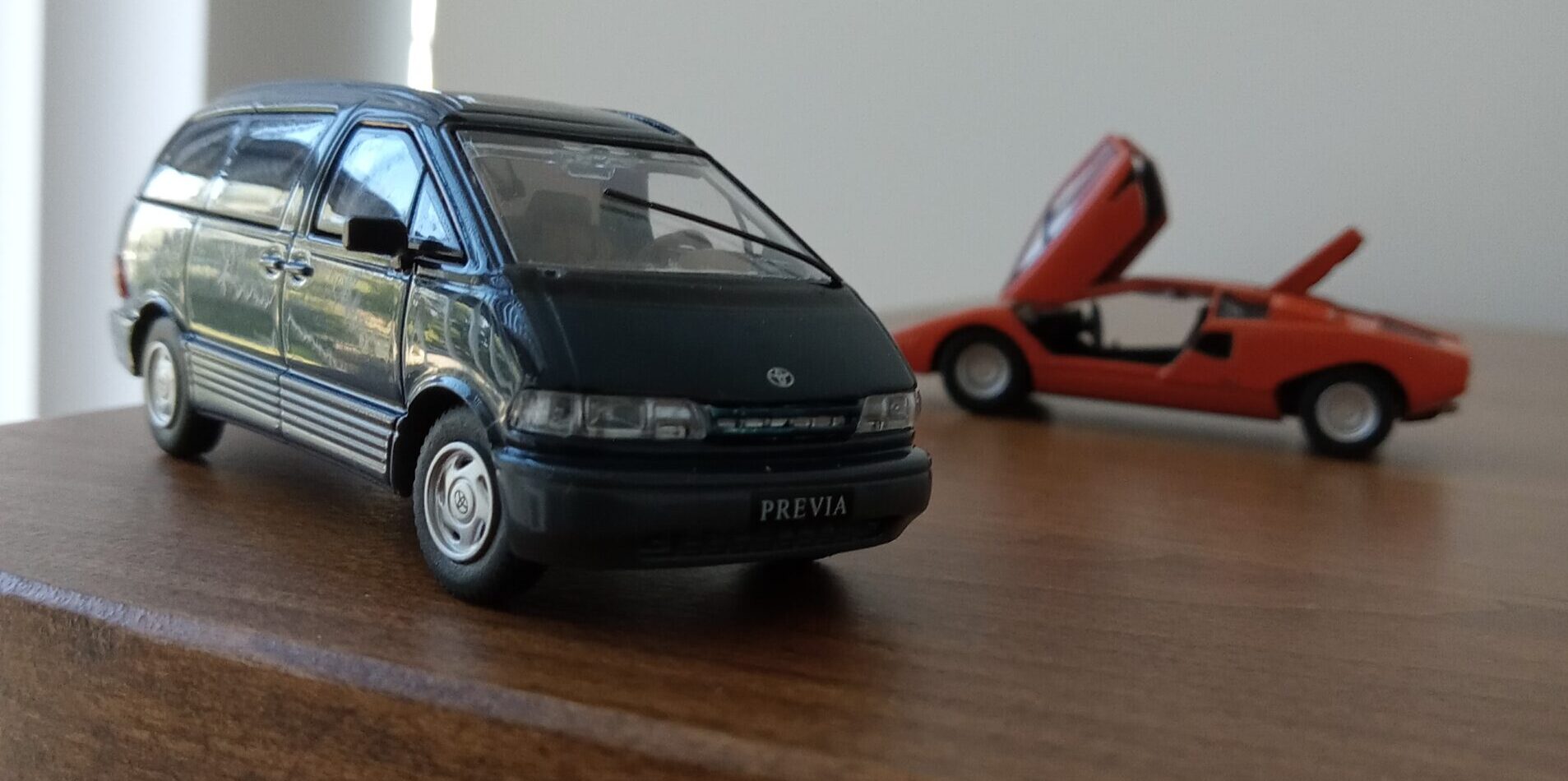
私にとってトヨタ エスティマ / プレビアは、
ミニバン世界の
『卵型・スーパーカー』
です。
現在のようにミニバンスタイルが確立され、スペース効率を追求した上でさらに操縦安定性も優れるベスト回答が出来上がる以前の創成期に、きら星のごとく登場した奇想天外なミニバン・デザイン模範解答の草稿たちの一群の中で、
*外観のキャラクター的にも、(ワンモーション・デザインの達成)
*技術的先進性的にも、(ミッドシップにエンジンを寝かせて搭載)
*また販売戦略的にも、(「天才卵」のキャッチコピー)
抜きんでた存在が『プレビア』でした。
プレビアの販売開始の1990年前後には世界中で、ミニバン的ないわゆる「ピープルムーバー」を目指した乗用車が各社から販売・提案され始めていました。
デザイン的に面白いものは、
こんな感じでした。
*ルノー・エスペース、
*ポンティアック・トランスポーター、
*シボレー・アストロバン、
*フィアット・ムルティプラ、
特筆すべき存在:
*ランボルギーニ・ジェネシス、1988(コンセプトカー)
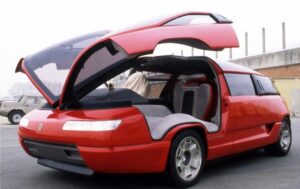
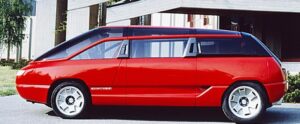
(シンプルながら、安定性と方向性の共存に成功している、ユニークなサイドビュー)
(ベルトーネがデザインした、ランボルギーニのミニバンコンセプトカーです。ランボルギーニのV12エンジンをフロント車軸上に搭載するなど、非常にユニークな特徴を持っていました。残念ながら実車化には至らず)
私の大好きなミニバンたちを語るのは最後の章に譲りまして、
以下のように進めていきたいです。
*実車解説:
*デザイン的特徴:客観的に見まして、、、、
*『私とプレビア』:主観が入ります!
*その他のデザイン・コンシャスなミニバンたち
*実車解説:『天才たまご』の正体?
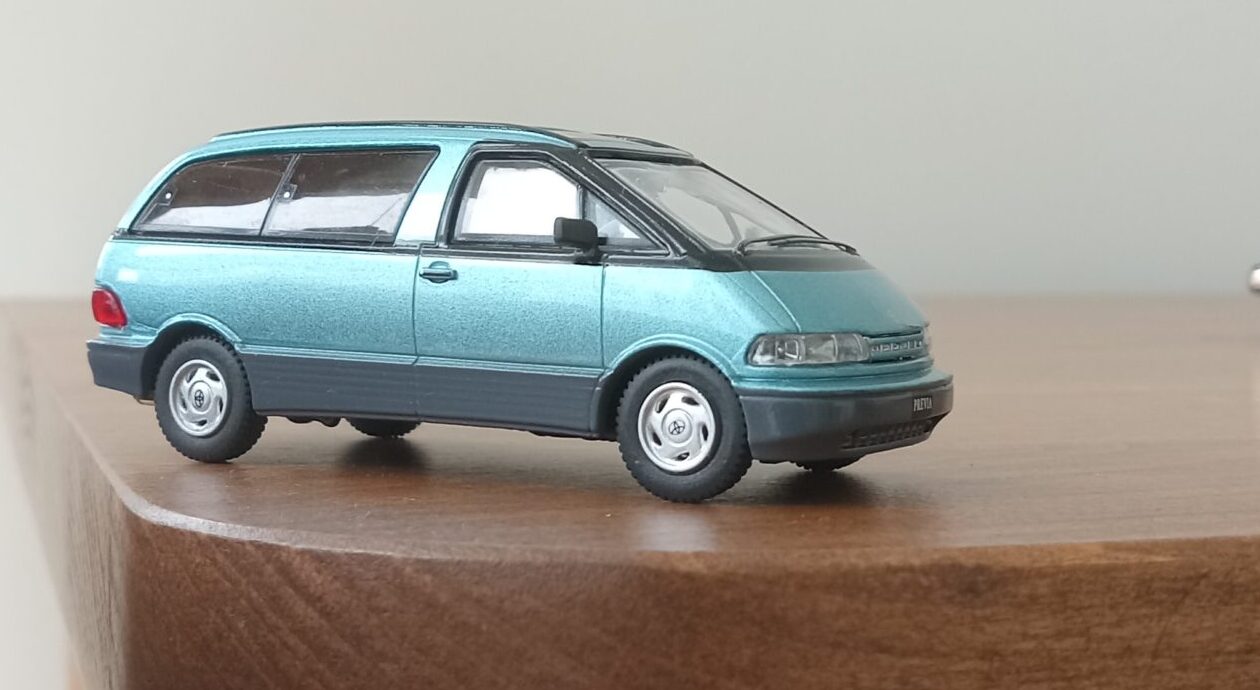
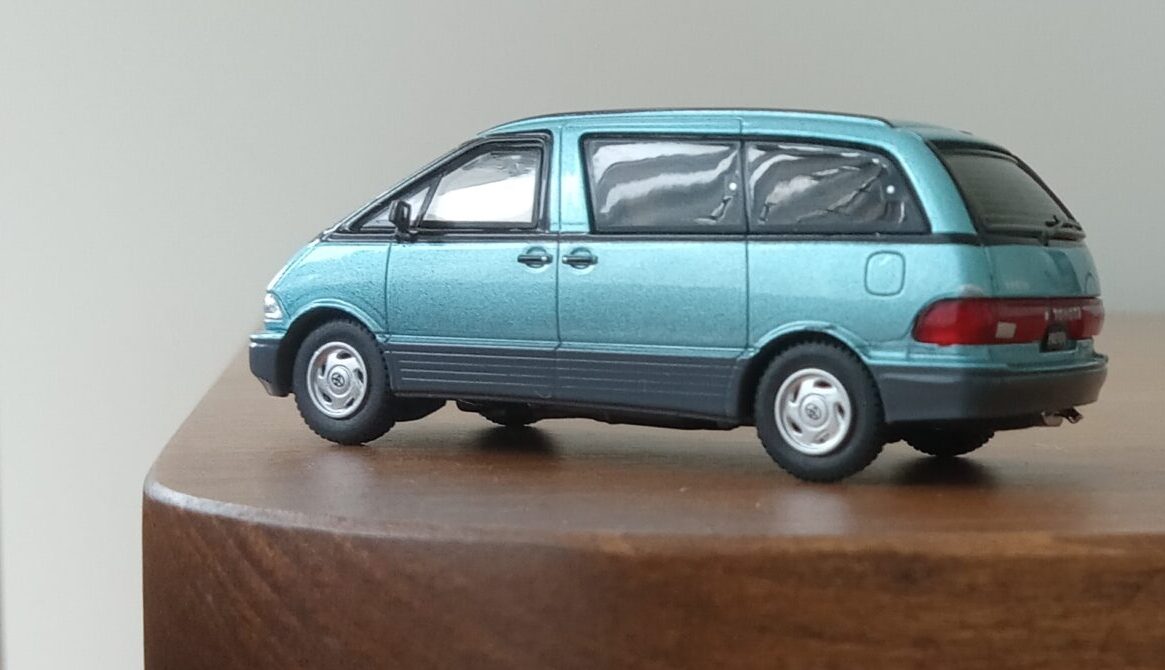 (GCD社製, 1/64トヨタ プレビア(グリーンマイカ/グレー))
(GCD社製, 1/64トヨタ プレビア(グリーンマイカ/グレー))
第28回東京モーターショーにコンセプトモデルとして出展、それから約半年後の1990年5月に市販化され、卵をイメージさせる未来的なスタイルで「高性能ニューコンセプトサルーン」として注目を集めました。従来のワンボックスカーでは前輪前・運転席下に位置しているエンジンを、横に75°寝かせ、前輪も運転席の前方に置くことにより、当時は世界でも類を見ないアンダーフロア型・ミッドシップレイアウトを実現、運動性能と大きな室内スペースの両立に成功しました。
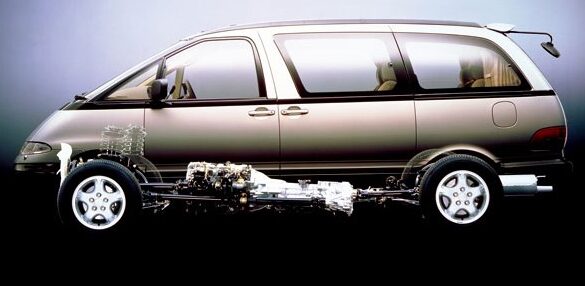

(スポーツカー以上に完璧にフロント中央に収まるミッドシップレイアウト、このエンジン位置は美しすぎます!!!!!!!!!!!!!!!!!)
「Egg on the BOX」のコンセプトによる未来的ボディ・デザインはは、トヨタ北米スタジオであるCALTYによるもの。ドアガラスまで3次元形状の球面スタイルは、強い曲率によるリヤガラスを含め、近寄るとそのオーラを感じるほどの完璧なワンモーションフォルム、後の世のミツビシ『アイ』の卵ボディーに先行すること30年の快挙です。 ボディー下3分の1を覆うサッコ・プレート的な大型樹脂製サイドプロテクターがミッドシップの低い重心を、(MS化に伴い前に押しやられたフロント車軸と合わせて、)安定感抜群のスタンスを極限まで強調。
販売成績的には、輸出先の北米では競争相手のアメリカ産ミニバンが3リットル以上のV6エンジンを載せていたことや、運転席直下に位置するエンジンによる騒音や振動問題により、また日本では当時としては大柄な1m80cmの全幅や300万円を超える価格などが災いして今一つな成績となりました。結局、1990年から2000の生産終了までに、16,5977台が販売され、FFカムリベースの2代目にバトンタッチされました。
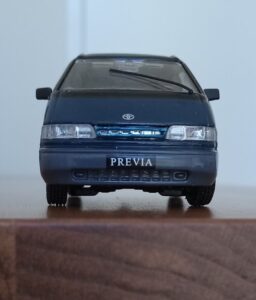
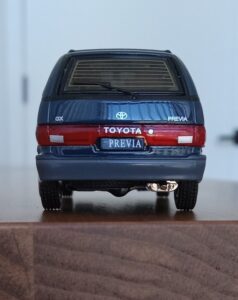
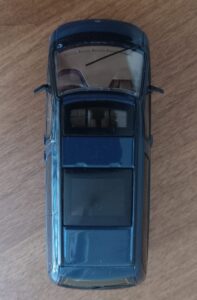
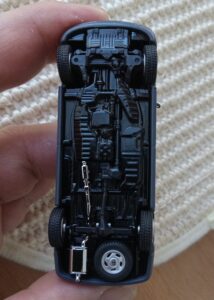
(GCD社製 1/64 トヨタプレビア
(ダークブルーマイカ/グレー))
主要諸元:
初代トヨタエスティマツインムーンルーフ
2WD仕様
全長4750×全幅1800×全高1820mm
ホイールベース:2860mm
車両重量:1770kg
エンジン型式:2TZ-FE
エンジン:2438cc、直列4気筒DOHC
最高出力:135ps/5000rpm
最大トルク:21.0kgm/4000rpm
サスペンション形式: (前)ストラット式、
(後)ダブルウイッシュボーン式
価格:307万円(4AT)
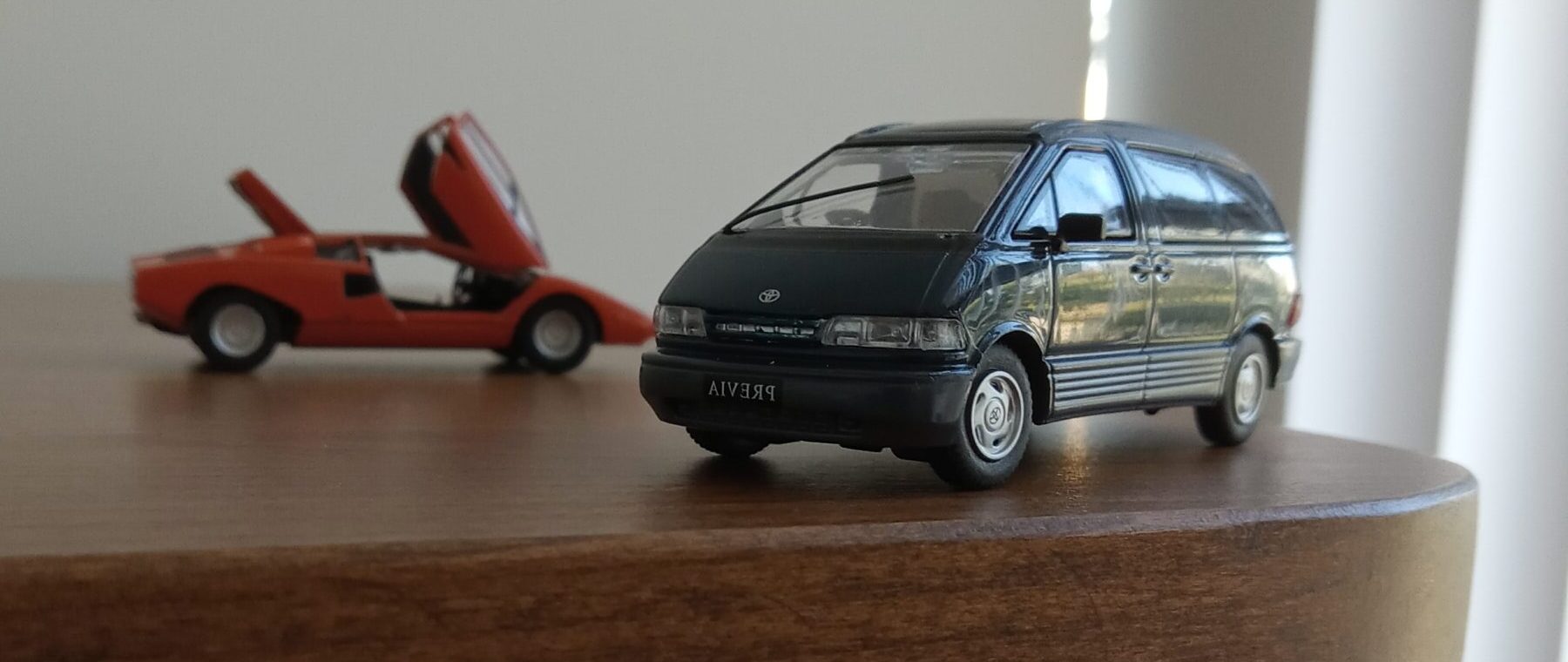
*デザイン的特徴:客観的に見まして、、、
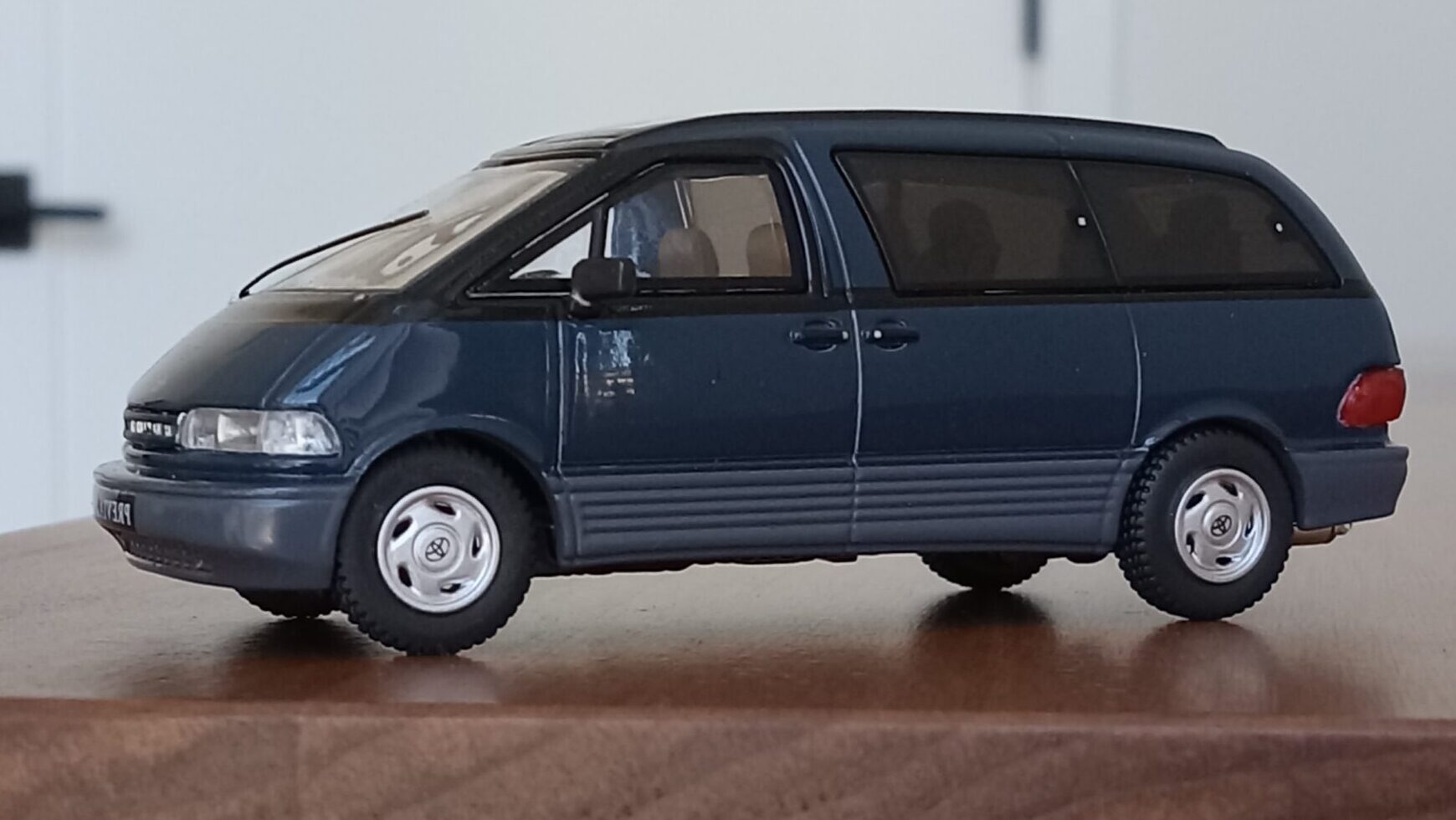
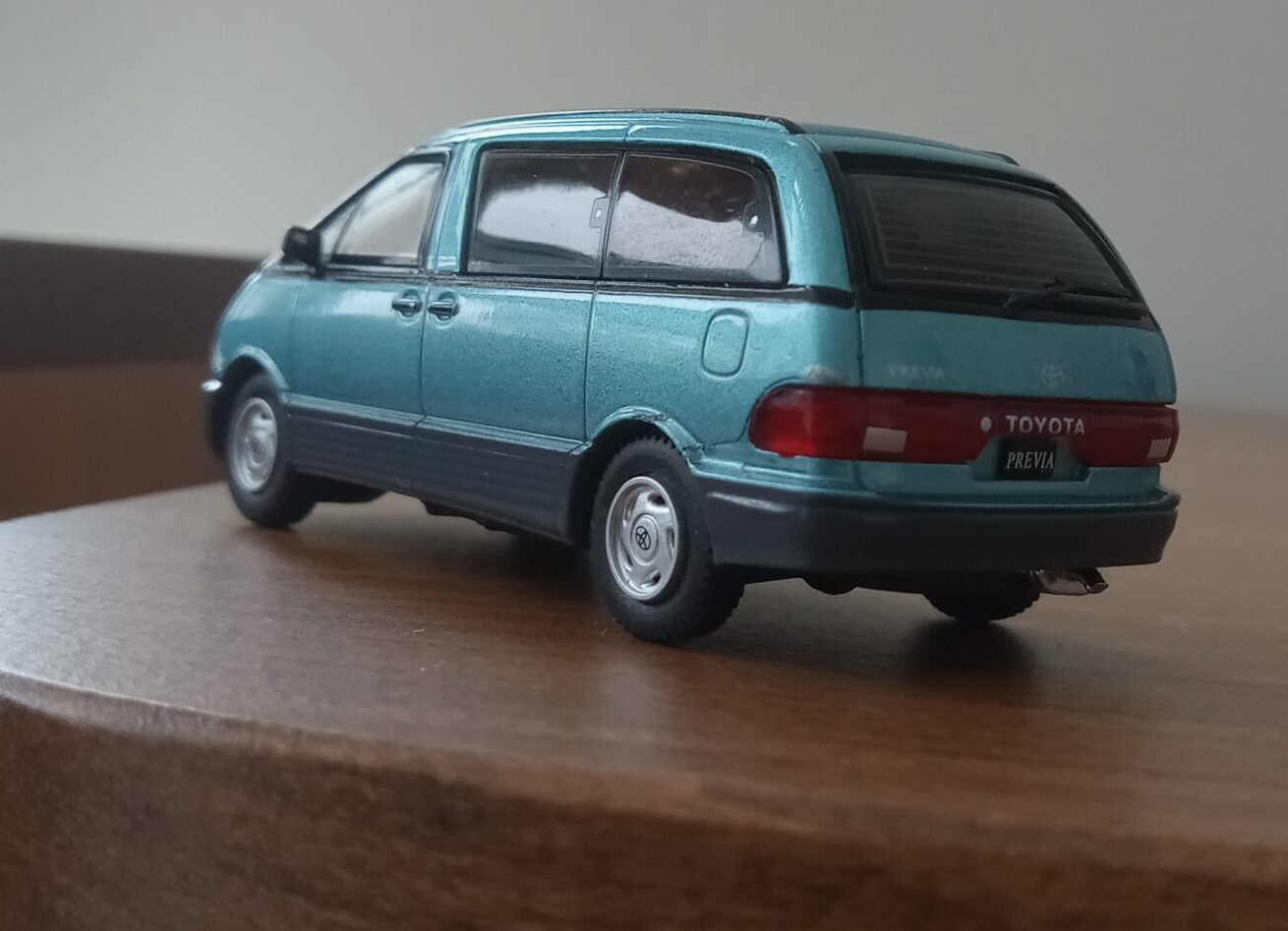
プレビアのデザインには、
以下のような特徴があります。
*ワンモーション『卵』 フォーム
*トヨタ版『サッコ・プレート』
*3層・グラフィックによる伸びやかさの演出
*前後フェイシアのボディーとの一体化
*スポーティーなBピラーの角度
ではそれぞれ詳しく見て行きましょう。
*ワンモーション『卵』 フォーム
(ミッドシップレイアウトにより実現可能となった長いホイールベースとありえないほどの曲面ボディーを見事につなぐ、一筆書きの名人芸!)
ーーーーー>唯一無二
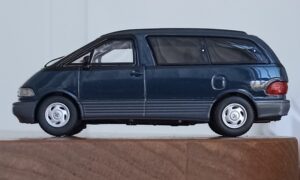
*トヨタ版『サッコ・プレート』
(当時すでに流行の兆しのあったボディー2分割をミニバンに応用)
ーーーーーーーー>特別間、豪華さの演出にも貢献
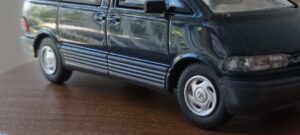
*3層・グラフィックによる伸びやかさの演出
(B,Cピラー以外の窓と窓枠をフラッシュサーフェイス化、ブラックアウトすることで、ボディーを上、中、下と3分割!)
ーーーーー>全体イメージの素晴らしい伸びやかさとしなやかさの演出に成功
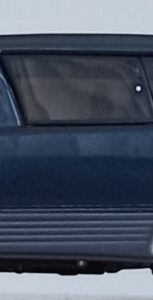
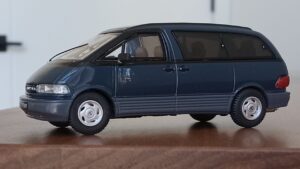
*前後フェイシアのボディーとの一体化
(徹底したフラシュ・サーフェイス化と、抑制のきいた気品あふれるライト造形)
ーーーーーーーーー>全体の『丸み感」を加速
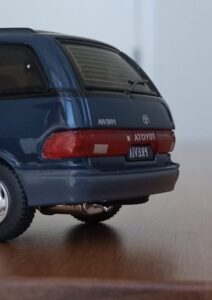
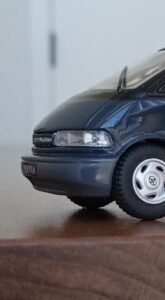
*スポーティーなBピラーの角度
(極太ながら、方向性を加速させる計算されつくしたBピラーの前傾角度)
ーーーーーーー>安心感とスポーティさの両立に成功
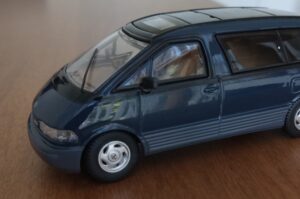
『私とプレビア』:7人乗りスーパーカー
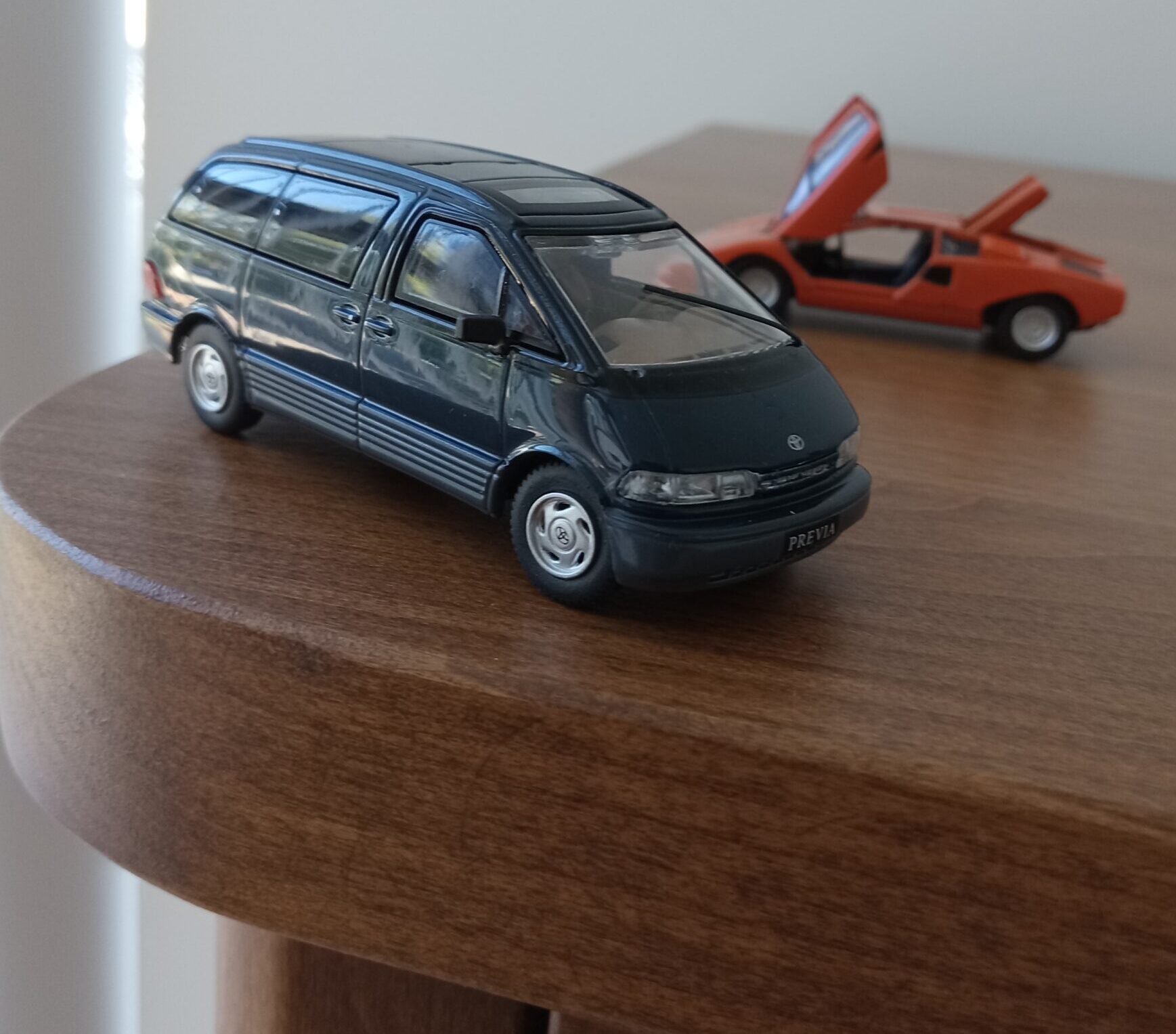
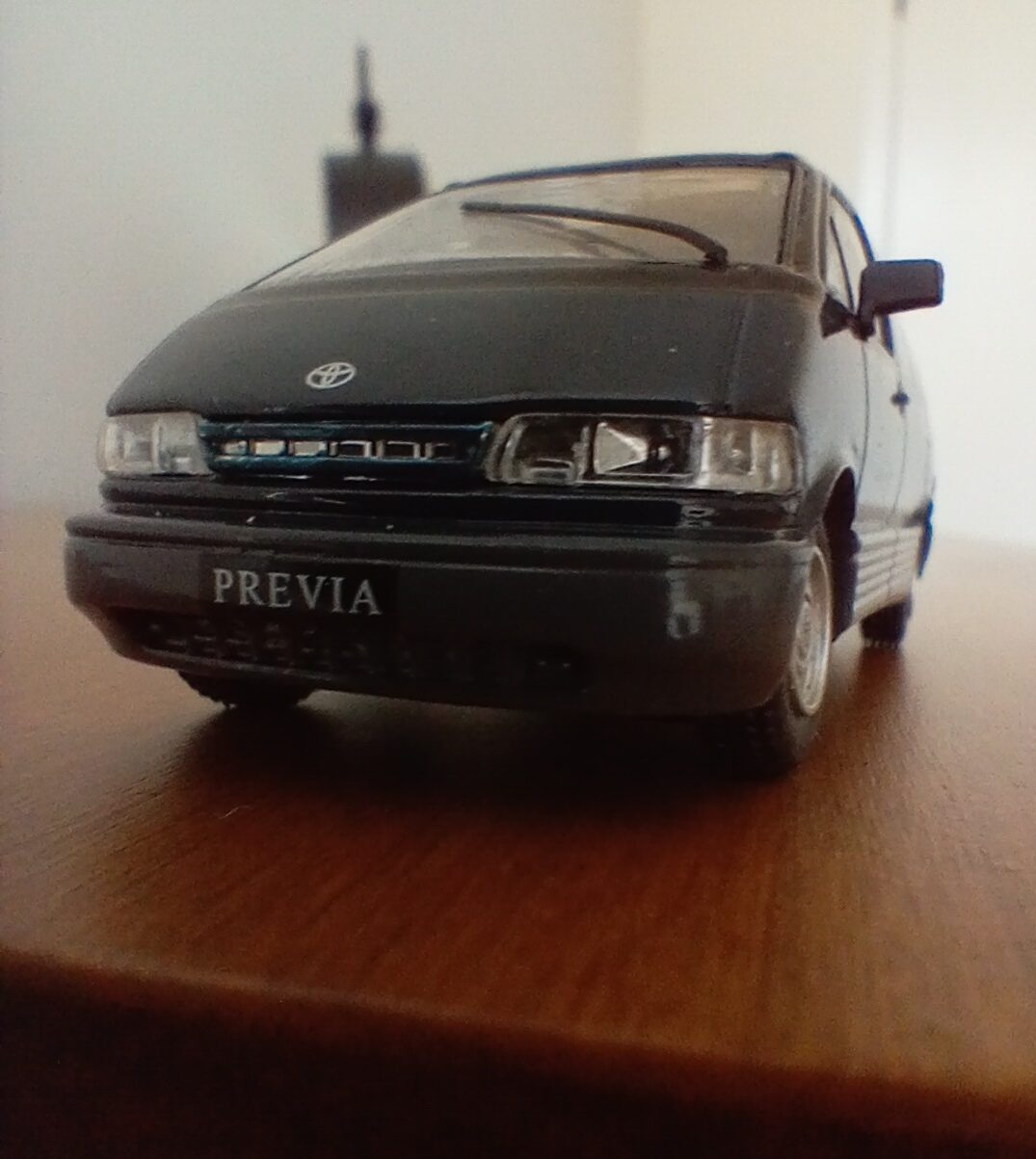
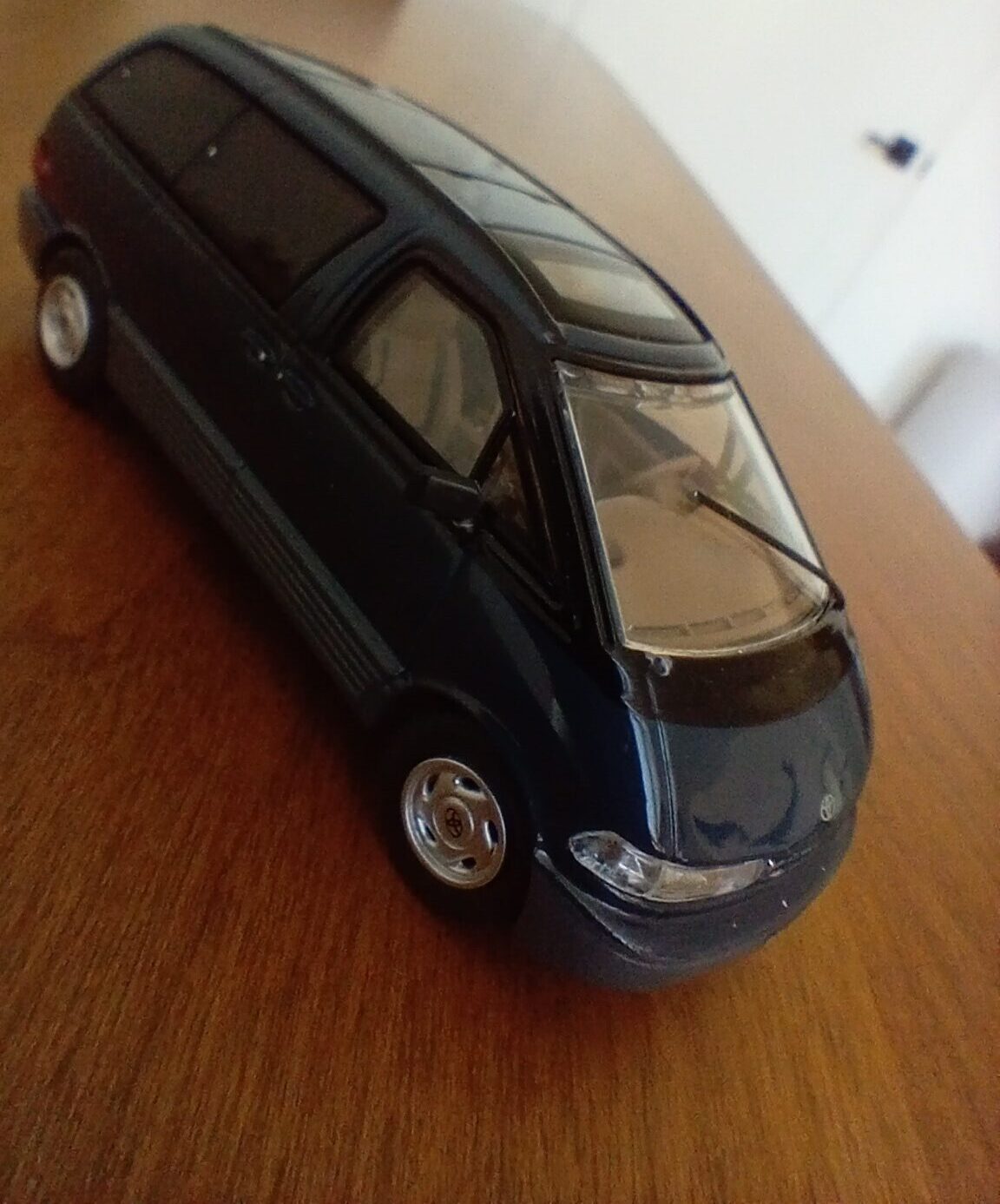
ここ10年ほどダウンタウンにあるオフィスからの帰宅途中の5時から6時ごろに、
中南米労働者に大人気の
送迎用の
乗り合いタクシー
として
初代プレビアが使われているのを目撃し続けてきました。
恐らく、
特殊なエンジン位置の整備方法を確立してしまえば、
*初代プレビアの中古価格はタダ同然なことも、
*超長持ちなトヨタエンジン、
*信頼のおけるパーツ供給、
*さらに、ランニングコストが非常に安いこと
などが理由だと思われます。
目前に列をなす乗客に
スーッと近づいてくる場面を目撃するたびに、
毎回なんだか得体のしれない
『オーラ』のようなものを
感じ続けてきました。
以前から大好きで敬意を表してきたデザインではあったのですが、
今回このプレビアを選んだのは、何とかしてその
オーラの出どころを
つかみたいという思いからにほかなりません。
出来の素晴らしいGCD社さんの1/64のミニカーをひねくり回して、迷走瞑想して実車の動きを網膜の裏側に再現してみたり、写真撮影をしたり、ブログ記事や、サイトを閲覧させていただきまくった、
その結果、
暫定的、オーラの出どころ:
*フロアー下(実際には運転席と助手席の真下)のミッドシップレイアウトを実現+プラス
*レッグスペース確保のためもあり、前輪車軸を思いっきり前倒し=イコール
*実際に真上から見れば、ロータス・エリート、エラン、などの極端に操縦性に優れたフロントミッドシップ・スポーツカーのエンジン位置に等しいかそれ以上に重心が中央寄り
結果として、
前のめりに前進したくてしょうがない、
これ以上ないぐらいに理想的かつ美しい、
『重量配分』が産む
生物感、そこからくる『魔物的匂い』
がオーラの正体では?
7人の乗客を快適に運ぶための卵型の外骨格部分が強調されがちですが、
それを載せるためのシャーシの構成自体は、
ほかに比較するものがないレベルでの、
まごうこと無き『スーパーカー』
そのものでした。
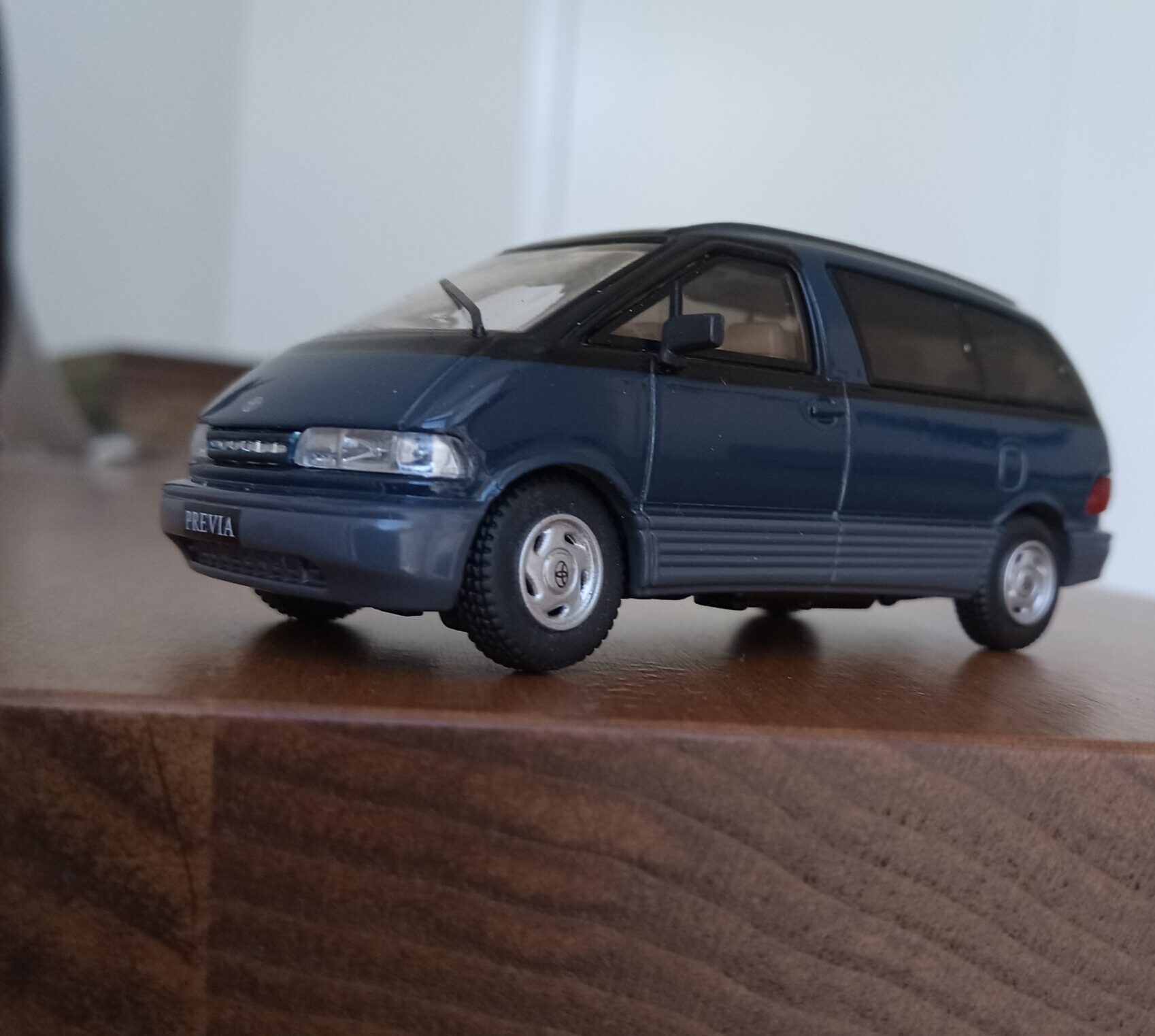
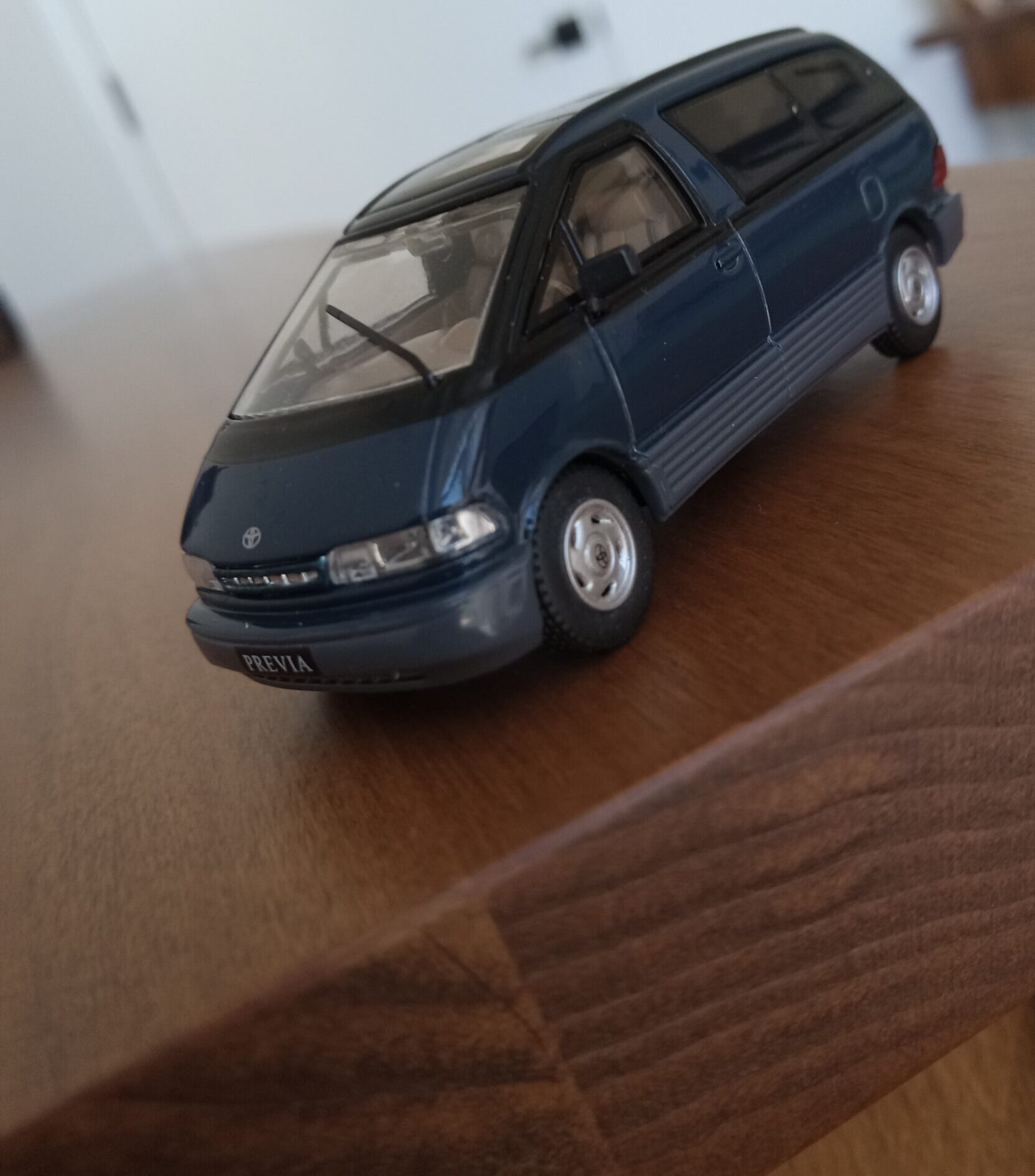
*その他のデザイン・コンシャスなミニバンたち
始めの章でお伝えしましたように、
私の好みのミニ・バン デザインは
こんな感じです。
*ルノー・エスペース、1984
(エスティマに先駆けること6年、二本あるAピラーの間の窓が特徴、3層に分かれたサイドビューグラフィックもエスティマに影響?とにかく先進的なコンセプト⁺販売面でも大成功した傑作車)
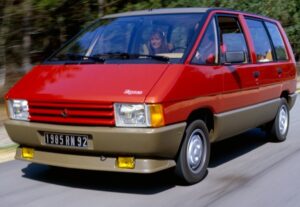
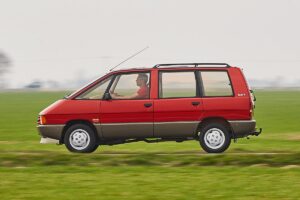
*ポンティアック トランススポーツ・コンセプト, 1986
(非常に美しいフロントノーズからルーフへつながるカーブとAMCペーサー譲りのリアウインドウ周りの丸さが魅力、トヨタと違いフロントオーバーハングにエンジンを積んだ生産型は、見るも無残な失敗作に終わったのが残念)
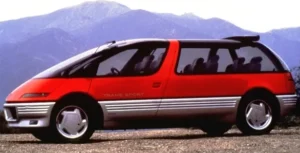
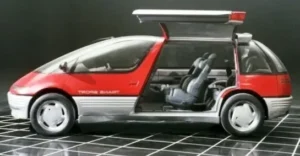
*シボレー・アストロバン、1985
(シンプルで武骨な外観はありそうでない、憎めない愛着のカタマリ。シンプルな故、改造にもうってつけ、前期のショートオーバーハング版が好みです。所ジョージさんの目の付け所の鋭さから、日本でも一時は年間1万台以上の大ヒット)
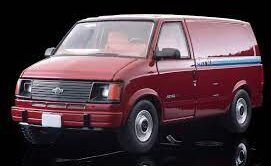
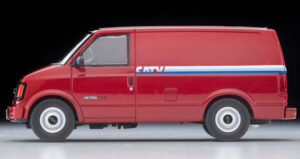
*フィアット・ムルティプラ、1998
(「世界で最も醜い車」と言われるほど、圧倒的で斬新な外見は、3+3の6人乗りと4メートル以下の全長の実現から生まれた特殊なパケージの産物。世界中で愛着を持って受け入れた大ファンも多数存在)
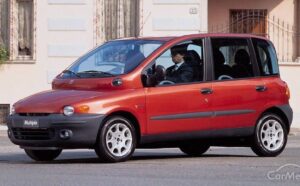
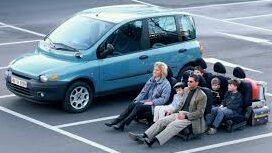
*日産 NV200 バネット, 2009
(商用中型バンのお手本的な小気味よく洗練されたパッケージと全体像、特にリアウインドウ周りから下へ流れるフラッシュサーフェイス化されたわずかに上向きにファイン・チューンされたボディー面は感涙モノ。世界戦略車としても成功をおさめ、2025年現在も現役で活躍中、ガンメタの商用車が欲しいです!)

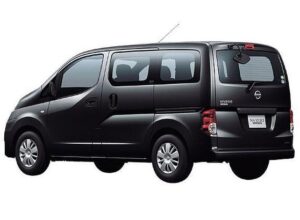
*2代目クライスラー・パシフィカ, 2016
(非常に上品かつ風格溢れる均整の取れたプロポーションとボディーサイドをリアバンパー前でぐるりと下へ展開したマイバッハ57、三菱グランディス等にみられるオリビエ‣ブーレイ時代のダイムラー・三菱譲りの繊細なボディーサイド表面が秀逸、売り上げ的にも上級プレミアムミニバンとして一定の成功を収める)

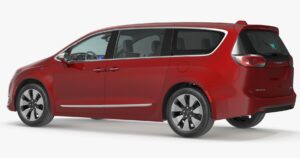
実用的なミニバンと言えども
こんなにも多彩なデザインが存在したんですね!
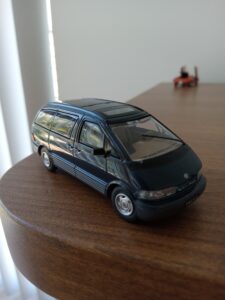
自動車デザインは本当に奥が深いです。
次回は少し趣向を変えまして、
映画『バック・トー・ザ・フューチャーPART2』から
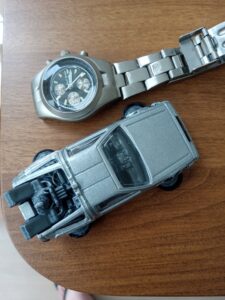
デロリアン(ホバー・カーバージョン)
について語ってみたいです。
お楽しみにー
!!!!!!!!!!!!!!!!!!!!!!!!!!!!!!!!!! Translation in English !!!!!!!!!!!!!!!!!!!!!!!!!!!!!!!!!!
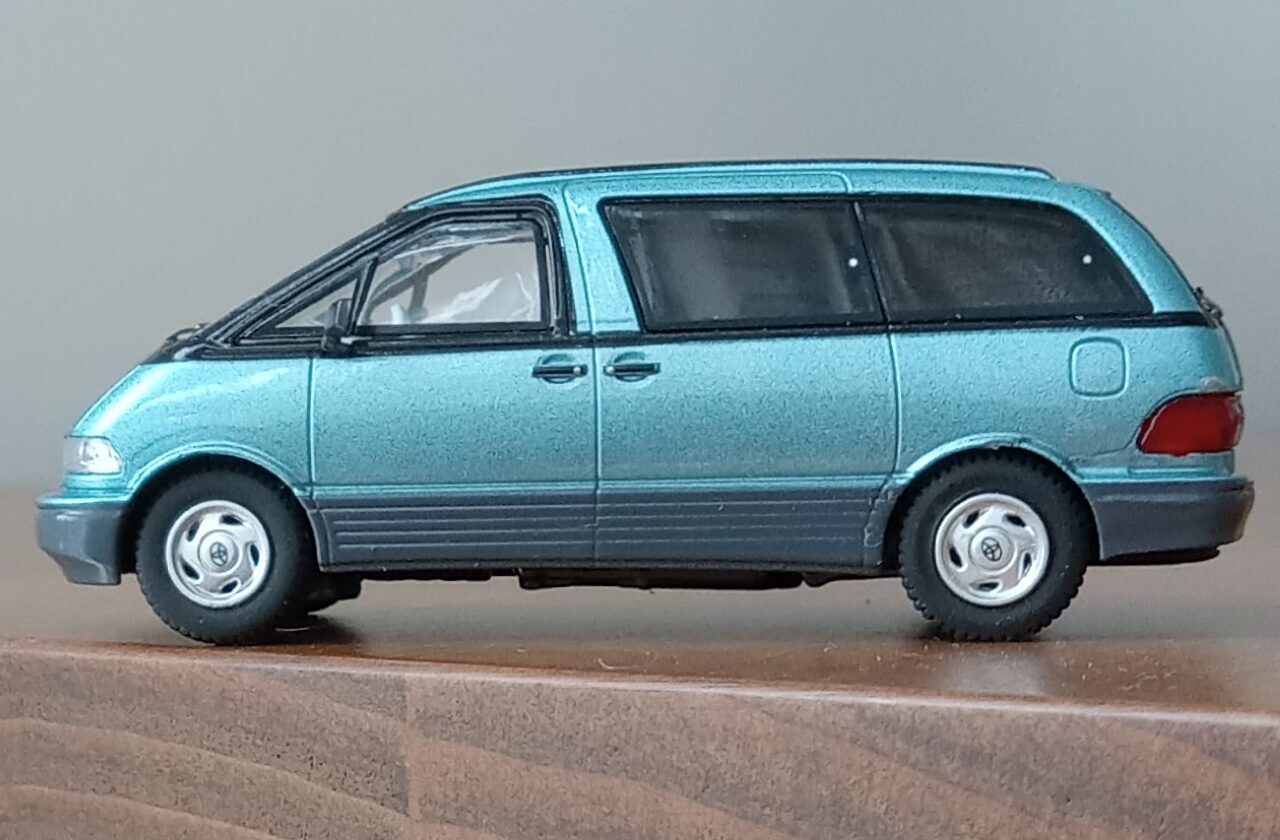
Part 6: Toyota, First-Generation Previa [Estima] (Exterior Color: Dark Blue Mica/Gray)

For me, the Toyota Estima / Previa is
the minivan world’s
‘Egg-Shaped Supercar’.
In the formative era before minivan styling was established as it is today—before the ultimate solution emerged that pursued space efficiency while also excelling in handling stability—it appeared like a shining star among a group of wildly imaginative minivan design prototypes.
*In terms of exterior character (achieving a one-motion design)
*In terms of technological advancement (laying the engine flat in a mid-ship configuration)
* And in sales strategy too (with the “Genius Egg” catchphrase)
The Previa stood head and shoulders above the rest.
Around 1990, when the Previa went on sale, passenger cars aiming to be minivan-like “people movers” were beginning to be sold and proposed by various manufacturers worldwide.
Design-wise, interesting examples included:
* Renault Espace,
* Pontiac Transporter,
* Chevrolet Astro Van,
* Fiat Multipla,
Notable exception:
* Lamborghini Genesis, 1988 (concept car)


(A simple yet unique side view successfully balancing stability and directional intent)
(This Lamborghini minivan concept car was designed by Bertone. It featured highly unique characteristics, such as mounting Lamborghini’s V12 engine over the front axle. Unfortunately, it never made it into production.)
I’ll save talking about my favorite minivans for the final chapter,
and proceed as follows:
*Real Vehicle Analysis:
*Design Features: Objectively speaking…
*‘Me and the Previa’: Subjectivity included!
*Other Design-Conscious Minivans
*Real Vehicle Analysis: The Identity of the ‘Genius Egg’?


Exhibited as a concept model at the 28th Tokyo Motor Show, it went on sale about six months later in May 1990. Its futuristic, egg-inspired styling garnered attention as a “high-performance new concept saloon.” By tilting the engine 75 degrees sideways—whereas conventional minivans placed it under the front wheels near the driver’s seat—and positioning the front wheels forward of the driver’s seat, it achieved an underfloor mid-ship layout unprecedented worldwide at the time. This successfully balanced dynamic performance with a spacious interior.


(A mid-ship layout positioned more perfectly at the front center than even a sports car—this engine placement is just too beautiful!!!!!!!!!!!!!!!!!)
The futuristic body design, based on the “Egg on the BOX” concept, was created by CALTY, Toyota’s North American design studio. Its three-dimensional spherical styling, extending even to the door glass, featured a rear window with strong curvature. Up close, its aura was palpable, a perfect one-motion form. This design achieved a remarkable feat, preceding Mitsubishi’s later ‘i’ egg-shaped body by a full 30 years. Large resin side protectors, resembling sacco plates covering the lower third of the body, emphasize the mid-ship low center of gravity to the extreme, creating an exceptionally stable stance (combined with the front axle pushed forward due to the MS conversion).
Sales performance, however, was less than stellar. In its North American export market, it faced competition from American minivans equipped with 3-liter or larger V6 engines. Additionally, e anoisnd vibration issues stemming from the engine positioned directly beneath the driver’s seat, coupled with its large overall width of 180 cm (over 180 cm) and a price exceeding 3 million yen, which was high for the time in Japan, contributed to its lackluster sales. Ultimately, 165,977 units were sold from its 1990 launch until production ended in 2000, after which the baton passed to the FF Camry-based second generation.




(GCD 1/64 Toyota Previa(Dark Blue Mica/Gray))
b
B
B
B
b
N
N
N
N
N
Key Specifications:
First-generation Toyota Estima Twin Moonroof
2WD specification
Overall length: 4750mm ×
Overall width: 1800mm ×
Overall height: 1820mm
Wheelbase: 2860mm
Curb weight: 1770kg
Engine code: 2TZ-FE
Engine: 2438cc, inline 4-cylinder DOHC
Maximum output: 135ps/5000rpm
Maximum torque: 21.0kgm/4000rpm
Suspension type: (Front) Strut type,
(Rear) Double wishbone type
Price: ¥3,070,000 (4AT)

*Design Features: Objectively speaking…


The Previa’s design
features the following characteristics:
*One-motion ‘egg’ form
*Toyota’s version of the ‘Sacco Plate’
*Three-layer graphics creating an impression of expansiveness
*Seamless integration of front and rear fascias with the body
*Sporty angle of the B-pillar
Let’s examine each in detail.
*One-motion ‘Egg’ Form
(A masterful stroke connecting the long wheelbase enabled by the mid-ship layout and the impossibly curved body!)
ーーーーー>Unique
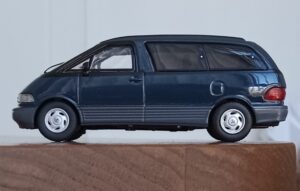
*Toyota-style ‘Sacco Plate’
(Applying the then-emerging trend of a two-piece body to the minivan)
────────> Contributes to a sense of exclusivity and luxury

*Three-Layer Graphics for a Sense of Flow
(By making the windows and window frames (except B and C pillars) flush surfaces and blacking them out, the body is divided into upper, middle, and lower sections!)
────────> Successfully creates a wonderful sense of flow and suppleness in the overall image
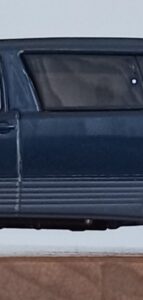

*Integration of front and rear fascias with the body
(Thorough flush surfacing and restrained, elegant light sculpting)
————————> Accelerates the overall ‘sense of roundness’
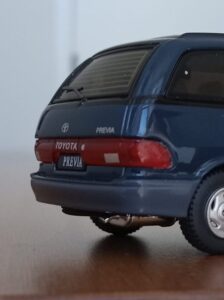

*Sporty B-pillar angle
(A thick yet meticulously calculated forward-leaning B-pillar angle that accelerates directional intent)
ーーーーーーー>Successfully balances reassurance and sportiness

‘Me and the Previa’: 7-seater supercar



For the past decade or so,
on my commute home from the downtown office around 5 to 6 PM,
I’ve consistently witnessed the first-generation Previa being used
as a shared taxi
for commuting
by Latin American workers,
who absolutely love it.
I suspect the reasons are:
* The first-generation Previa’s used price is practically free,
* Its ultra-durable Toyota engine,
* Reliable parts supply,
* And extremely low running costs.
Every time I witness one gliding smoothly toward the line of passengers waiting before it,
I continue to sense some kind of inexplicable
‘aura’ emanating from it.
While I’ve long loved and respected its design,
my choice of this Previa this time stems solely from a desire to somehow grasp
the source of that aura.
I’ve spent hours twisting and turning GCD’s superbly crafted 1/64 scale mini car, lost in meditation trying to recreate the real car’s movements on the back of my retina, taken photos, and devoured blog posts and websites.
The result:
Provisional source of the aura:
* Achieving a mid-ship layout under the floor (actually directly under the driver and passenger seats) + Plus
* To secure legroom, the front axle is pushed as far forward as possible = Equals
* Viewed directly from above, the center of gravity is as close to the center as, or even more so than, the engine position in extremely agile front-mid-engine sports cars like the Lotus Elite or Elan
The result is:
An irresistible urge to lunge forward,
The most ideal and beautiful possible,
Born from this ‘weight distribution’
A sense of living organism,
and the ‘demonic aura’ emanating from it
Isn’t that the true nature of the aura?
While the egg-shaped exoskeleton designed to comfortably carry seven passengers tends to be emphasized,
the chassis structure supporting it
was itself
an unmistakable ‘supercar’
at a level beyond comparison.


*Other Design-Conscious Minivans
As mentioned in the first chapter,
my preferred minivan designs
look something like this.
* Renault Espace, 1984
(Preceding the Estima by 6 years, featuring a window between two A-pillars; its three-tiered side view graphics also influenced the Estima? An advanced concept⁺ and a masterpiece that was also a huge commercial success)


* Pontiac Trans Sport Concept, 1986
(Its charm lies in the beautiful curve flowing from the front nose to the roof and the rounded rear window area inherited from the AMC Pacer. Unlike Toyota, the production model placed the engine in the front overhang, resulting in a regrettably disastrous failure.)


*Chevrolet Astro Van, 1985
(Its simple, rugged exterior is both familiar yet unique—a lovable, endearing mass. Its simplicity made it perfect for customization; I prefer the early short-overhang version. Thanks to Mr. Tokoro George’s keen eye, it became a huge hit in Japan too, selling over 10,000 units annually at one point.)


*Fiat Multipla, 1998
(Its overwhelmingly novel appearance, often called “the world’s ugliest car,” was born from the unique packaging required to achieve a 3+3 six-seater layout within a sub-4-meter length. It still has a devoted global fanbase who embrace it affectionately.)


*Nissan NV200 Vanette, 2009
(A textbook example of a mid-size commercial van, its crisply refined packaging and overall silhouette are a joy to behold. The flash surface treatment around the rear window, flowing downward with a subtly upward-tapered body line, is truly moving. It succeeded as a global strategic model and remains active as of 2025. I want a gunmetal-colored commercial version!)


*Second-generation Chrysler Pacifica, 2016
(Its exceptionally refined and dignified proportions are superb, featuring the delicate body side surfaces inherited from the Daimler-Mitsubishi era of Olivier Boulet—seen in the Maybach 57 and Mitsubishi Grandis—where the body side curves downward around the rear bumper. It achieved solid sales success as a premium minivan.)


Even among practical minivans,
such a diverse range of designs existed!
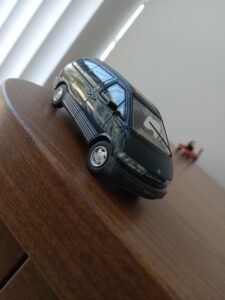
Automotive design truly has immense depth.
Next time, changing things up a bit,
I’d like to talk about
 the DeLorean (hover car version)
the DeLorean (hover car version)
from the movie ‘Back to the Future Part II’.
Stay tuned!
Translated with DeepL.com
これはCTAサンプルです。
内容を編集するか削除してください。
